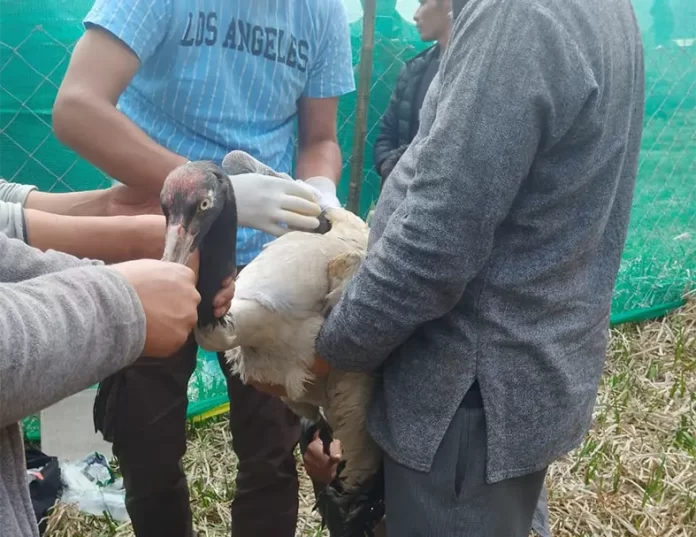[ Prem Chetry ]
BOMDILA, 8 Apr: An injured black-necked crane has been relocated to Morshing village in West Kameng district, after being medically treated for a month.
The crane, along with its female partner, had been attacked by feral dogs while on a visit
to Chug Valley on 6 March. The crane could not recover on time, and its female partner left for its destination a couple of weeks ago.
Bomdila DFO Obang Tayeng said, “It’s for the first time that an endangered bird species has been relocated, maintaining all protocols and formalities.”
“The temperature is rising in Chug Valley, which is not suitable. During summer, the temperature reaches up to 20°C. Zemithang in Tawang district is preferable, though medical aid could not be provided, whereas Morshing is found to be conducive for the bird to be relocated,” the DFO said.
“It is a lesson for us. There is a need for a well-equipped rehabilitation centre for high-altitude species,” the DFO said, adding that in the near future there are potential threats to such high-altitude migratory species, owing to habitat fragmentation, feral dogs, electrocution, and human interference.
A proposal for a mitigation plan, to be set up in Mandala Top in West Kameng district, is being planned by the Bomdila forest division.
As per Senior Veterinary Officer Dr Darge Tsering, the bird had suffered multiple injuries in the radial and metacarpal region, with extensive damage to the muscles, secondary feathers, and a few primary feathers, learnt to have been inflicted due to mauling by stray dogs. The injury was 4-5 days old when it was rescued. The best possible ethical treatment and management was advocated, adhering to protocols, and the bird was retained overnight at the veterinary dispensary in Dirang for observation.
The next day, the injured bird was shifted to a temporary enclosure built in close proximity to its female partner in a paddy field in Chug Valley. Round-the-clock vigil was kept to avoid any kind of external disturbance, and to minimise stress and imprinting.
Taking cognisance of the situation, PCCF (WL&BD) N Tam visited the crane in Chug Valley. He interacted with the veterinary officer and the Bomdila DFO, and advised them to “deploy all efforts in healing up the injuries of the crane, so that it could return back to its flock and its destination.”
The Bomdila DFO expressed gratitude to the heads of Chug and Morshing villages, the WWF, the WTI and the state Veterinary Department for their constant support and assistance. He anticipated that the injured bird will be able to join his flock next season.
The majestic black-necked crane is a highly revered bird among the Monpas of West Kameng and Tawang districts, besides for the people of Bhutan.
According to the IUCN Red List, the total population size of the black-necked crane is around 10,000-10,200 individuals, including around 6,600-6,800 mature individuals. Currently, this species is classified as ‘near threatened’ on the IUCN Red List. It is protected under Schedule-I of the Wildlife (Protection) Act, 1972, and is in the ‘vulnerable category’ as per the IUCN.





